There’s an old saying that goes “Everything’s bigger in Texas.” The phrase covers the number of snakes in the state too because Texas has more variety of snakes than any other state.
That’s due to its incredible size, but also because Texas has habitats from dry deserts to coastal waters that create ideal habitats for everything from water snakes to rattlesnakes, to harmless garter snakes.
We’ve tallied up 96 different types of snakes (species and sub-species) of snakes found in Texas. We’ll start with common snakes that are non-venomous, then move on to water snakes, and finish with venomous snakes you’ll find in the state. At the end of this article, you’ll be able to ID many of the most common and dangerous snakes found across the Lonestar State.
Let’s get started!
Common Snakes Found In Texas
Most of the snakes that live in Texas are non-venomous. By our count, there are about 82 types of snake stocks you can encounter in the state that lack venom. Most are harmless and would avoid any confrontation with humans.
However, if cornered or threatened they can still bite. Let’s take a look at some of the more common snakes you may run into. Each one is non-venomous and they range from a little over a foot to up to 8 feet long!
Texas Garter Snake
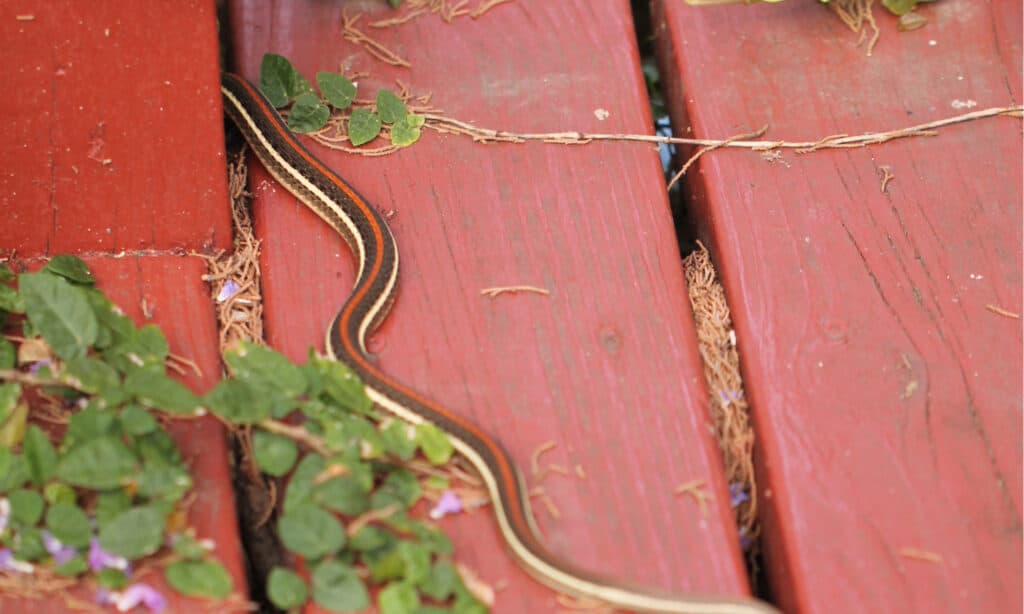
Texas
garter snakes
have a right stripe that runs the length of their body and yellow stripes on either side.
©Cathleen Wake Gorbatenko/Shutterstock.com
| Scientific Name | Range | Size |
|---|---|---|
| Thamnophis sirtalis annectens | Most common in prairies and lakes region | Up to 2 feet 4 inches long |
The Texas garter snake is a subspecies of the garter snake. Garter snakes are the most common snakes around the country and there are many different types of them. The Texas garter snake looks similar to other garter snakes, it’s usually just one to two feet long and very thin. It has an olive or brown body and two thin yellow stripes all along the body.
What makes the Texas garter snake different is that in addition to the two yellow stripes it also has a thin red stripe that runs the length of its body. This reptile loves the water and is never found too far away from a pond or wetland. And while they prefer forests, grasslands, and woodlands, they’re not averse to slithering onto your lawn either.
Are they venomous? Yes, they are. However, thankfully, their bites are not fatal since their venom is rather mild.
Western Hognose Snake
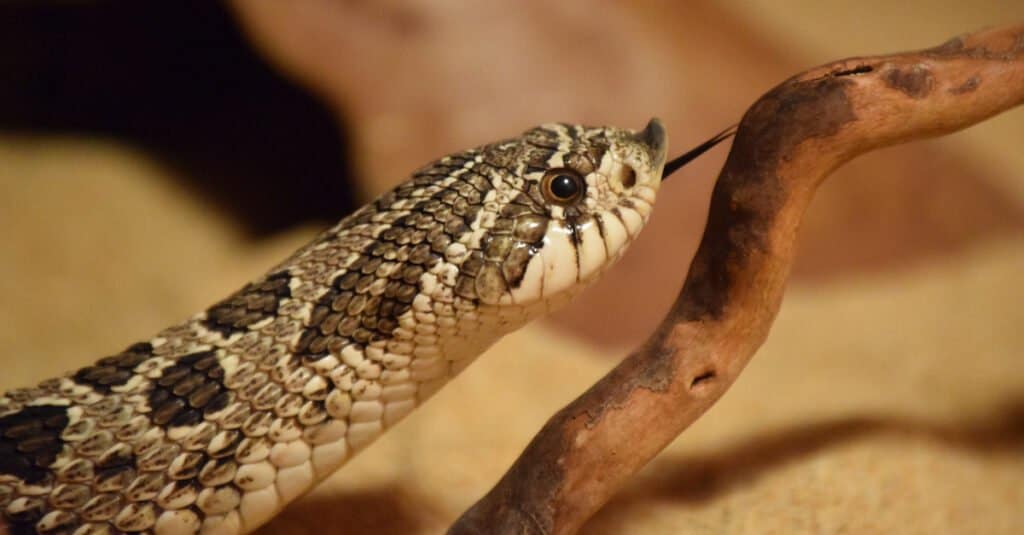
Western hognose snakes have an upturned scale at the tip of their nose that helps them dig through sand and loose soil.
©Bryn Thomas/Shutterstock.com
| Scientific Name | Range | Size |
|---|---|---|
| Heterodon nasicus | More common in West Texas | Up to 3 feet long |
The western hognose snake also likes sandy soil, but this snake prefers dry sandy soil like the kind that is in semi-desert areas.
There is a lot of desert and semi-desert in Texas and you can find western hognose snakes across much of Texas because of that, though they’re less common in the eastern part of the state. Western hognose snakes are not usually longer than two feet, although females can reach a maximum of three feet long.
They have brown, tan, or olive bodies and darker marking patches on their backs. What really sets these snakes apart is their nose. You can identify a Hognose snake by the upturned flat nose. That nose is what makes it easy for these snakes to burrow into the sand.
Milk Snake
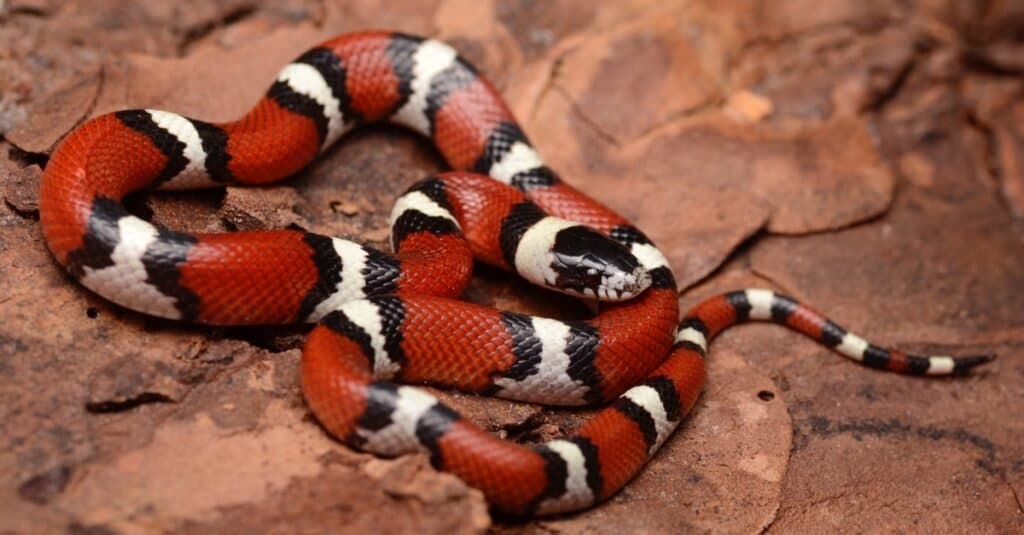
Louisiana Milk-snake found after a fall cold front blew through southeast Texas. The common name “milk snake” originated from the false belief that these snakes milked cows.
©TheTexasNaturalist/Shutterstock.com
| Scientific Name | Range | Size |
|---|---|---|
| Lampropeltis triangulum | 4 subspecies can be found across much of the state | Up to 3 feet long |
The milk snake is an imposter that looks like a venomous coral snake. But the milk snake is not venomous. There are four different types of snakes in Texas that mimic the look of a Coral snake to try and fool predators. Milk snakes are about a foot and a half to two feet long and they have wide bands of bright red all down the length of their bodies.
Its color around the bands will tell you whether the snake is a milk snake or a venomous coral snake. If the thin bands next to the red bands are black it’s a milk snake. If those thin bands are yellow it’s a Coral snake and you need to be very careful around that snake.
There are four subspecies of milk snakes in Texas (New Mexico, Louisiana, Central Plains, and Mexican) that are all similar in appearance but have subtle differences. The milk snake also looks very similar to the scarlet kingsnake, another non-venomous snake species that mimics the appearance of a coral snake.
Bullsnake

Bull Snake
©iStock.com/92968526
| Scientific Name | Range | Size |
|---|---|---|
| Pituophis catenifer sayi | Western 2/3 of the state, not found near the Louisiana border | Up to 8 feet long |
The bullsnake is one of the largest non-venomous snakes in the country. Some can be almost eight feet long. Bullsnakes have a color pattern that is very similar to the color pattern of a venomous diamondback rattlesnake.
Sometimes if they are threatened or cornered bullsnakes will wave their tails and try to rattle to make predators think they are the venomous diamondback, but really they are not venomous. However, bullsnakes will still bite or act aggressively at times so it’s always smart to approach them with caution or leave them alone entirely.
These subspecies of the gopher snake are fond of coniferous forests, grasslands, and woodlands. Their presence in your backyard is not necessarily a bad thing. Mice, rats, and even other rattlesnakes tend to be a favorite food item for these reptiles, making them something of a handy cleanup crew of sorts.
Yellow-Bellied Racer Snake
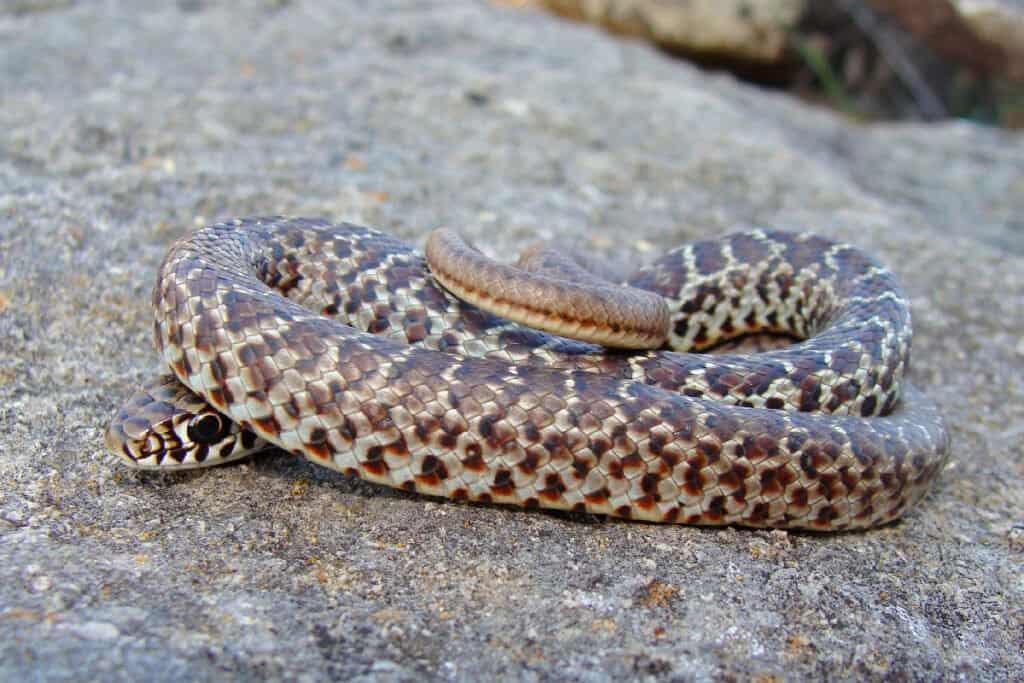
As juveniles yellow-belly racers have blotches, but when they age they turn olive-green.
©Matt Jeppson/Shutterstock.com
| Scientific Name | Range | Size |
|---|---|---|
| Coluber constrictor flaviventris | Found most commonly in East Texas but also can be found along the Rio Grande near Big Bend | Up to 5 feet long |
As you might have guessed from the name, a yellow-bellied racer snake is famous for its yellow belly. However, the appearance of the snake changes radically as they age. As juveniles (above picture), they have blotches across their body. Once they’ve aged to adulthood, they take on an olive-green color.
These snakes are about five feet long usually and they are very thin. They can be extremely fast and sometimes move at speeds of 3-4 miles per hour. Yellow-bellied racer snakes also are a bit aggressive and they will bite. These snakes are not venomous, but any snake bite can be painful and require medical attention so it’s always best to be cautious if you run across a Yellow-Bellied Racer snake.
Water Snakes in Texas
Texas is home to many lakes, especially in its eastern half. With rivers, lakes, and marshland abundant across the state, it’s no surprise that Texas has its fair share of water snakes. A water snake is a snake that belongs to the genus Nerodia, there are 10 distinct species in this genus, and seven of them live in Texas. Water snake species in Texas include:
- Salt Marsh Snake
- Mississippi Green Water Snake
- Plain-bellied Water Snake
- Broad-banded Water Snake
- Brazos Water Snake
- Concho Water Snake
- Diamondback Water Snake
It’s important to note that none of these water snakes are venomous. If you’re in the water and see a venomous snake it’s like a cottonmouth, which we’ll explore in more detail in our venomous snake section. But first, let’s take a look at the diamondback water snake, a species that’s common throughout much of Texas.
Diamondback Water Snake
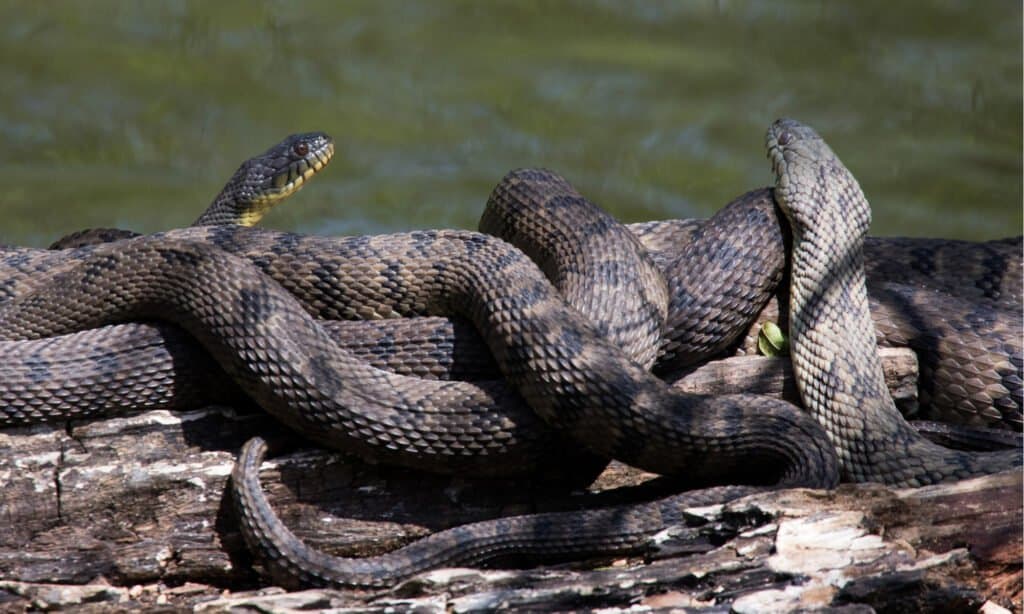
Diamondback water snakes will congregate in groups along the water.
©Laurie L. Snidow/Shutterstock.com
| Scientific Name | Range | Size |
|---|---|---|
| Nerodia rhombifer | Most of the state aside from arid counties near the border with New Mexico | Up to 6 feet long |
Diamondback water snakes are a common site next to many slow-moving bodies of water across the state. The snakes have reached a maximum size of almost 6 feet, but are more commonly 3 to 4 feet long. The snake prefers to hunt by suspending over water on either rocks or branches and watching for fish beneath the surface. While diamondback snakes are not aggressive – they’d prefer to flee into the water – if cornered their bites can be painful. The snake can have a similar coloration to cottonmouth snakes but is non-venomous.
Venomous Snakes In Texas
There are a lot of venomous snakes in Texas, but most of them are rattlesnakes. In addition to several types of rattlesnakes, the other venomous snakes in Texas are the copperhead snake, coral snake, and the western cottonmouth snake. Let’s take an examination of each type of venomous snake beginning with rattlesnakes.
Rattlesnakes in Texas

The
Mojave rattlesnake
typically grows to between 3.3 ft and 4.5 ft in length.
©Creeping Things/Shutterstock.com
There are more than 9 different kinds of rattlesnakes in Texas. Even though that might make it seem like you have a pretty good chance of getting bitten by a rattlesnake in Texas there are actually relatively few rattlesnake bites each year. According to the Texas Parks and Wildlife Department, there are about 7000 venomous snake bites in the United States each year. On average, those bites lead to just 5 fatalities.
The biggest thing you need to remember is that any rattlesnake is going to make that distinctive rattle sound with its tail. If you hear that rattle, freeze in your tracks. Back up slowly. Don’t make any sudden movements and get out of that area as quickly as you can. That is the best way to prevent a rattlesnake bite. The types of rattlesnakes in Texas are:
- Massasauga
- Desert massasauga
- Western Massasauga
- Mojave Rattlesnake
- Prairie Rattlesnake
- Rock Rattlesnake
- Banded rock rattlesnake
- Motted rock rattlesnake
- Timber Rattlesnake
- Western Diamondback Rattlesnake
- Western Pygmy Rattlesnake
Rattlesnakes are not the only venomous snakes in Texas though.
Copperhead

There are two species of
copperheads
in Texas
©iStock.com/David Kenny
| Scientific Name | Range | Size |
|---|---|---|
| Agkistrodon contortrix | Not found in the Panhandle Plains and South Texas Plains | Up to 4 feet long |
Copperhead snakes have such good camouflage that when you’re in Texas plains or semi-desert areas you could look right at a copperhead snake and not even see it. You will most likely hear it before you see it. These snakes love the sandy soil of the Texas semi-desert and the Texas heat. Be very careful where you step or where your horse steps if you are walking or riding in the semi-desert or desert because there could very well be a copperhead nearby.
There are two species of copperhead in the state. The eastern copperhead (Agkistrodon contortrix) and the brown-banded copperhead (Agkistrodon laticinctus). The brown-banded copperhead sometimes known as the Texas copperhead is more expansive across the state, being found all the way into the Big Bend area of West Texas.
In comparison, eastern copperheads only live in the eastern 1/3 of the state. It’s important to note that while copperheads are not aggressive, due to their incredible camouflage they’re often stepped on or interfered with more than other venomous snakes. For that reason, there are more venomous bites from copperheads than any other snake in the United States.
Coral Snake

Coral snakes are brightly colored and have distinctive bands
©iStock.com/JasonOndreicka
| Scientific Name | Range | Size |
|---|---|---|
| Micrurus tener | Not found in the high plains and mountainous areas surrounding El Paso | Up to 4 feet long |
Coral snakes have extremely bright colors and they usually stand out. There are several snakes in Texas that mimic the colors of a coral snake but a true Coral snake has wide red bands that are bordered by thin yellow bands. Look for the yellow bands and if you see them back away as slowly as you can to avoid provoking the snake.
While coral snakes can grow up to 4 feet in length, most only reach about half that size. Rather than striking their victims with fangs, they release their venom by chewing on their prey. While dangerous, fatalities from this species of snake are extremely uncommon.
Western Cottonmouth

Cottonmouth snake
©Jay Ondreicka/Shutterstock.com
| Scientific Name | Range | Size |
|---|---|---|
| Agkistrodon piscivorus | Most commonly found in the eastern half of the state near water | Up to 5 feet long |
Cottonmouth snakes are also sometimes called water moccasins. They are aquatic and stay near or in the water so you will only find them near lakes and rivers or in some areas of the coast. Cottonmouth snakes are long and usually dark olive green or black in color.
The primary way to identify a cottonmouth snake is to look at the mouth. If there is a patch of white under the chin or on the sides of the mouth it’s a cottonmouth snake. In addition, cottonmouths have arrow-shaped heads and pits under their eyes that snakes similar in appearance (diamondback water snakes) will lack.
While these snakes can grow up to five feet, generally they’re closer to two to three feet. When threatened they will often open their jaws and expose a very white mouth, hence the name “cottonmouth.”
A Complete List Of 96 Snakes In Texas
The number of snakes in Texas will forever be changing. For one, snakes move into new territories and are also extirpated from the state. Also, the process of determining which snakes are their own distinct species versus being “merely” a subspecies of another snake is a field that is the subject of considerable debate and constantly changes.
However, one thing is clear: Texas has a greater variety of snakes than any other state in the Union. Below, we’ve compiled 96 different snakes that can be found in Texas. 82 are not venomous while 14 of these snakes are and deserve additional attention. For each snake, if they’re a subspecies we’ve batched them underneath the species they belong to.
82 Non-venomous Snakes in Texas
- Baird’s Rat Snake
- Big Bend Blackhead Snake
- Big Bend Patchnose Snake
- Black-striped Snake
- Black neck Garter Snake
- Blind Snakes
- Plains blind snake
- Trans-Pecos blink snake
- New Mexico blind snake
- Brazos Water Snake
- Broad-Banded Water Snake
- Bullsnake (Gopher Snake)
- Checkered Garter Snake
- Coachwhip Snake
- Eastern coachwhip snake
- Western coachwhip snake
- Common Garter Snake
- Texas Garter Snake
- New Mexico Garter Snake
- Concho Water Snake
- Crayfish Snake
- DeKay’s Brown Snake
- Marsh Brown Snake
- Texas Brown Snake
- Desert Kingsnake
- Diamondback Water Snake
- Eastern Hognose Snake
- Flathead Snake
- Glossy Snakes
- Kansas glossy snake
- Texas Glossy snake
- Painted desert glossy snake
- Graham’s Crayfish Snake
- Gray-banded Kingsnake
- Ground Snake
- Indigo Snake
- Long-nosed Snake
- Louisiana Pine Snake
- Mexican Blackhead Snake
- Mexican Hognose Snake
- Mexican Hooknose Snake
- Milk Snake
- Central Plains milk snake
- Mexican milk snake
- Louisiana milk snake
- New Mexico milk snake
- Mississippi Green Water Snake
- Mud Snake
- Northern Cat-eyed Snake
- Plain-bellied Water Snake
- Plains Blackneck Snake
- Plains Garter Snake
- Prairie Kingsnake
- Racers
- Mexican racer
- Southern black racer
- Buttermilk racer
- Tan racer
- Eastern yellow-belly racer
- Rat Snakes
- Redbelly Snake
- Ring-necked Snake
- Regal ring-necked snake
- Mississippi ring-necked sanke
- Prairie ring-necked snake
- Rough Green Snake
- Salt Marsh Snake
- Scarlet Snakes
- Texas scarlet snake
- Northern scarlet snake
- Schott’s Whip Snake
- Slowinki’s Corn Snake
- Smooth Earth Snake
- Smooth Green Snake
- Southwestern Blackhead Snake
- Speckled Kingsnake
- Speckled Racer
- Sriped Whip Snake
- Texas Lyre Snake
- Texas Lined Snake
- Texas Night Snake
- Texas Patchnose Snake
- Trans-Pecos Rat Snake
- Western Hognose Snake
- Western Hooknose Snake
- Western Rat Snake
- Texas Rat Snake
- Western Ribbon Snake
- Arid land ribbon snake
- Gulf Coast ribbon snake
- Redstripe Ribbon Snake
- Western Worm Snake
14 Venomous Snakes in Texas
- Black-tailed Rattlesnake
- Brown-banded Copperhead
- Cottonmouth
- Eastern Copperhead
- Massasauga
- Desert massasauga
- Western Massasauga
- Mojave Rattlesnake
- Prairie Rattlesnake
- Rock Rattlesnake
- Banded rock rattlesnake
- Motted rock rattlesnake
- Texas Coral Snake
- Timber Rattlesnake
- Western Diamondback Rattlesnake
- Western Pygmy Rattlesnake
Other Reptiles Found in Texas
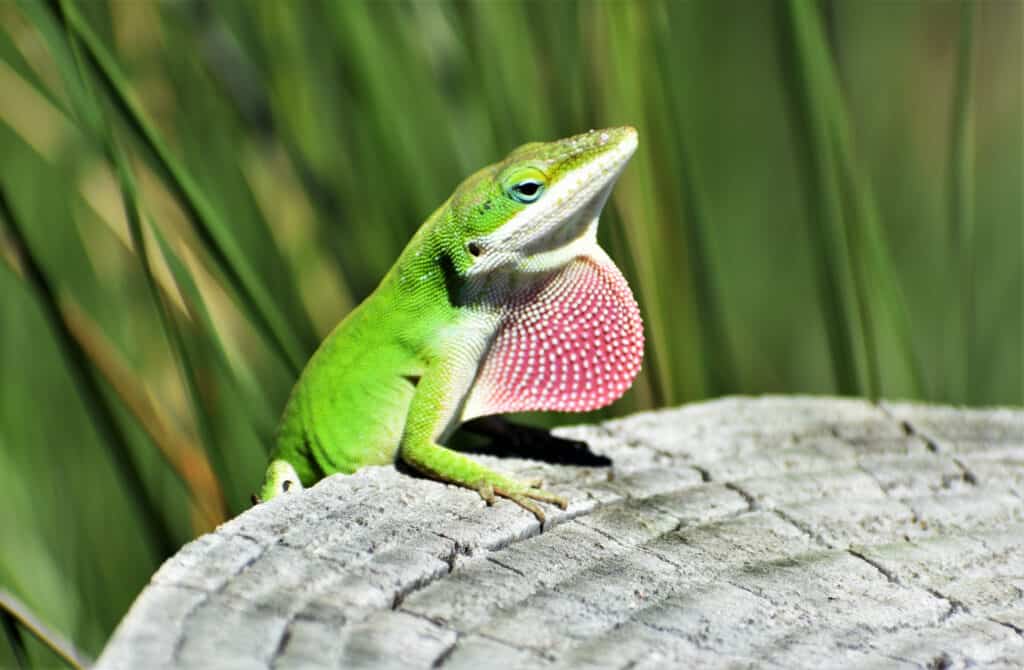
Lizards like the
Green Anole
do “pushups” to attract mates.
©victoria.schell/Shutterstock.com
The state of Texas is renowned for its diverse wildlife, ranging from the majestic American alligator to the elusive Texas horned lizard. Among this rich tapestry of creatures, Texas is home to a wide variety of reptiles that have adapted to the state’s unique climate and landscapes.
From the colorful and agile green anole to the spiky and formidable Texas spiny lizard, the reptiles of Texas come in all shapes and sizes, each with their own distinctive features and behaviors.
Here is a list of other reptiles that are found in Texas:
- Anoles:
- Green Anole (Anolis carolinensis)
- Brown Anole (Anolis sagrei)
- Spiny Lizards:
- Texas Spiny Lizard (Sceloperus olivaceus)
- Alligator Lizards:
- Texas Alligator Lizard (Gerrhonotus infernalis)
- Legless and Alligator Lizards (Anguidae)
- Collared and Leopard Lizards:
- Collared and Leopard Lizards (Crotaphytidae)
- Eyelid Geckos:
- Eyelid Geckos (Eublepharidae)
Which U.S. State Has the Most Snake Bites?
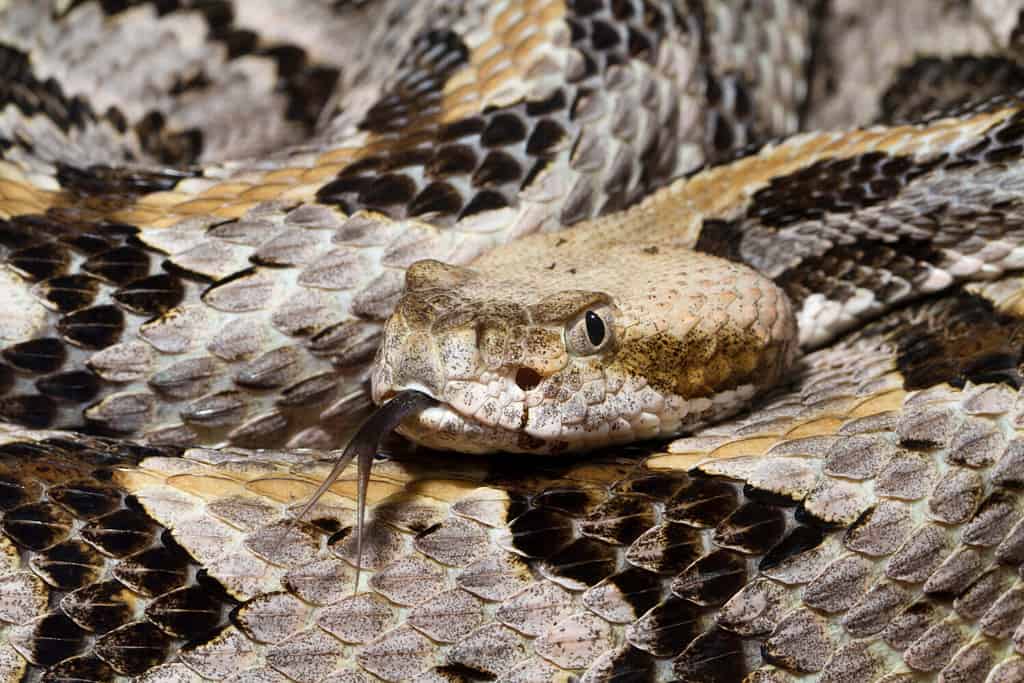
The venomous timber rattlesnake is among those responsible for snake bites in North Carolina.
©Mark_Kostich/Shutterstock.com
As we’ve discovered, there’s a whole lotta snake species slithering around in Texas. In fact, Texas ranks 6th in the nation for snake bites per year, specifically, 44.2 million snake bites per million population.
But which state ranks the highest in snake bites? That would be North Carolina. The snake bite rate in this southeastern state is 157.8 bites per million population annually. As the population as of 2021 was a little over 10 million (10.55 to be exact), and we were to just figure it off of 10 million, that would average out to roughly 1,580 reported snake bites per year.
The top 6 states for reported snake bites are:
| Rank | State | Bites per Million |
|---|---|---|
| 1 | North Carolina | 157.8 |
| 2 | West Virginia | 105.3 |
| 3 | Arkansas | 92.9 |
| 4 | Oklahoma | 61 |
| 5 | Virginia | 48.7 |
| 6 | Texas | 44.2 |
There are 6 different kinds of venomous snakes inhabiting North Carolina: copperhead, cottonmouth, eastern coral snake, eastern diamondback rattlesnake, pigmy rattlesnake, and timber rattlesnake. In the year 2019, there were 92 people bitten by venomous snakes in that state.
The photo featured at the top of this post is © Creeping Things/Shutterstock.com
Discover the "Monster" Snake 5X Bigger than an Anaconda
Every day A-Z Animals sends out some of the most incredible facts in the world from our free newsletter. Want to discover the 10 most beautiful snakes in the world, a "snake island" where you're never more than 3 feet from danger, or a "monster" snake 5X larger than an anaconda? Then sign up right now and you'll start receiving our daily newsletter absolutely free.
FAQs (Frequently Asked Questions)
What rattlesnakes are found in Texas?
Texas is home to 10 different rattlesnakes that include:
- Western Diamondback Rattlesnake
- Timber Rattlesnake
- Banded Rock Rattlesnake
- Mottled Rock Rattlesnake
- Black-Tailed Rattlesnake
- Mojave Rattlesnake
- Prairie Rattlesnake
- Western Massasauga
- Desert Massasauga
- Pygmy Rattlesnake
Thank you for reading! Have some feedback for us? Contact the AZ Animals editorial team.






